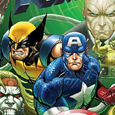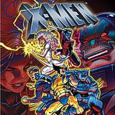Filmation (1973), Paramount Home Entertainment/CBS DVD (November 21, 2006), 4 discs, 526 mins plus supplements, 1.33:1 original full frame ratio, Dolby Digital 5.1/2.0 Mono, Not Rated (Rated G in Canada), Retail: $54.99
Storyboard:
These are the animated but nonetheless continuing voyages of the star ship Enterprise. Captain Kirk, Mister Spock, Dr. McCoy, and the rest are all here, exploring the galaxy, encountering new life, new civilizations, and boldy going where no man has gone before.

The Sweatbox Review:
In 1966, a show debuted that would forever redefine science fiction on television, not to mention the nature of organized fandom. When Star Trek ended its three-year run in 1969, it left behind a legacy of thought-provoking, groundbreaking futuristic drama. As we all know by now, the show found its greatest success in reruns after completing its network appearances. Over time, its fans became more organized and planned increasingly larger conventions. A movie series was spawned, whose success in turn led to spin-off television series, the first of which also got its own movies. Along the way, there were also countless magazines, books, and toys produced to cash in on the public’s love of Star Trek, a show that lasted all of three seasons.
Well, four, really.
Yes, four.

The relevance of the 1973 animated Star Trek series has been debated by fans from time to time, and with the release of the show on DVD the debate has begun anew. Created by Filmation, the same studio responsible for a number of other TV show and comic book adaptations, the animated version can make a surprisingly strong case for being considered “canon”. Original series creator and producer Gene Roddenberry served as the animated series’ executive consultant. D.C. (Dorothy) Fontana reprised her duties as story editor (while also serving as associate producer), and she asked previous Trek writers to contribute to the show. Add in the original cast doing voices, and it is hard to see why anyone wouldn’t think of the animated version as “Season Four.”
Having read numerous articles about the show, I can recall often seeing people lament that it was aimed at children. I find that comment ill-considered. It is true that certain allowances had to be made, but the show never stooped to pandering to a “kiddie” audience. Any of the stories could have been expanded into a regular episode of the live action show (it would have only taken the addition of a “B” storyline), with intriguing dilemmas, exciting action, and charming character interplay. If anything, the show was too grown-up for its own good, not really fitting into the Saturday morning milieu of the time. True, the messages of the episodes may have tended towards being less “heavy”, but not every live action episode had weighty issues explored either; and any cheese or jokiness that one perceives could be had in equal doses of the original, live action version. (On the other hand, Captain Kirk is a bit less of a horndog in the animated version.) Ironically, the animated series did pick up an Emmy Award in 1975 for “Best Children’s Series,” even though Filmation head Lou Scheimer always protested that it was never a children’s show! Thus, his only Emmy was received under (light) protest. The fact is, there was no other place for the show to air in 1973 aside from Saturday morning. Had it been done today, it would undoubtedly be a prime time show.
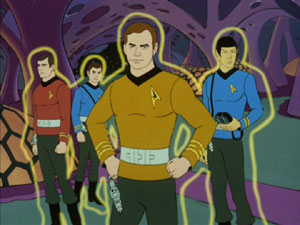
The animated Star Trek ran for two seasons, comprised of sixteen and six episodes. It was rerun sporadically afterwards, and received home video releases on tape and laserdisc. Yet, many Star Trek fans have only read about the show, and unfortunately have often been misled into thinking that the animated version is inferior. Thankfully, Paramount has at last collected the entire series into one nice DVD set, the final Trek series to reach DVD. I expect that many will pick this up out of curiosity or out of a sense of “collector’s completeness compulsion”, but will end up being surprised and delighted by the show’s stories. On the other hand, it must be admitted that the animation itself is unspectacular, so for those whose enjoyment relies on snazzy animation your entertainment will be curtailed. (One cost of this is that character’s faces lack the emotion that the actors always portrayed in the live action series; this is probably the weakest aspect of the animated version.) This was Filmation, after all, operating on budget standard at the time (reportedly $75,000 an episode— less than what a Superman cartoon short cost in the 1940s). The show used its share of stock footage, limited animation, and recycled music cues.
But for me, it is the stories that matter. Beyond The Farthest Star gets things off to a good start, with a story by Sam Peeples, writer of one of the Trek pilots (not to mention Filmation’s later Flash Gordon TV movie). In this episode, the Enterprise encounters a bizarre star ship while on a star-charting mission. Immediately, the benefits of animation become clear, as the crew beams over to the interior of the other ship. The grandeur and size of the ship would have been impossible to achieve on the original series. On the other hand, we also see the introduction of “life support belts,” which feels a little off and marks this as a different flavor from the older show. The appearance of that odd, six-limbed crewmember in Chekov’s chair (Lieutenant Arex) is another giveaway. (A feline Lieutenant M’Ress, voiced by Majel Barret, also appears from time to time in later episodes.) Though this turns into a pretty standard alien-monster-on-the-ship type of plot, it is a strong episode and a good way to start the series.

I won’t comment on all 22 episodes, but do have to mention the next one. Yesteryear, written by Fontana herself, is often cited as the series’ best episode, though there is one ridiculous hole in the story that has always bugged me. In this one, Spock has to travel back in time to save himself, since through a nonsensical time paradox his future self failed to do so once before. I know that paradoxes are inherent to time travel stories, but this one left too much unexplained. (Why was future-Spock ever originally in the past to begin with?) Nonetheless, it does offer a unique opportunity to visit Spock’s home world of Vulcan and to see him at a young age interacting with his peers and father. And, any episode with the Guardian Of Forever is just plain cool.

The series goes on to mine delightfully familiar territory, with the crew typically coming across new worlds or strange phenomena. Highlights include Uhura’s chance to captain the Enterprise in The Lorelei Signal; a sequel to one of the original series most memorable episodes, More Tribbles, More Troubles; meeting the Devil in The Magicks Of Megas-Tu; a return to the amusement planet in Once Upon A Planet; the return of Harry Mudd in Mudd’s Passion; the ship’s computer goes crazy in The Practical Joker; Dr. McCoy gets arrested for creating a terrible plague in Albatross; and the crew meets an Aztec deity in How Sharper Than A Serpent’s Tooth.
I have to say that the character models were well designed, because everyone on the show stays very nicely on-model for every episode. Well, both men and women seem to have over-developed pectorals, but other than that the likenesses are clear. I also thought it was good how they gave Spock a different complexion than his Earthling Caucasian companions.
Naturally some episodes are stronger than others, but it all feels like Star Trek. Consider it the fourth year of its five-year mission, with a couple of new crew members added in to keep things from getting stale. The familiar interplay between William Shatner, Leonard Nimoy, and DeForest Kelly is as entertaining as ever. Shatner reportedly nailed his lines regularly in one take, while the other two gents were of course consummate professionals. One never gets the idea that anyone was “slumming” on this show. As Fontana says in the special features, everyone worked as though this was the next season of Star Trek, without the makeup and costuming. To me, this is authentic Star Trek, and watching it is a delight. Animation weaknesses aside, this is a great show.
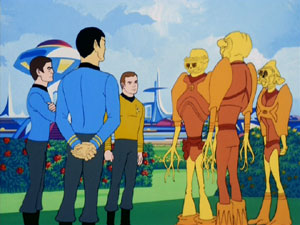
Is This Thing Loaded?
First off, the animated menus are pretty nice. Right away, you know that Paramount was taking this release seriously. (They even offer up the Stardate for each story on the episodes menu, for all you continuity sticklers.) Actually, the first disc initially offers the option of going to the Main Menu or Previews (for Star Trek TV sets, and The 4400: Season 2). Another bonus on this disc is the Text Commentary for Yesteryear, written by Michael and Denise Okuda (who have done so on other Trek DVDs). Their text, available in English, Spanish, or Portuguese, gives background on the workings of the series and explains links to other Trek shows in terms of staff, cast, and storylines— quite interesting for Trek enthusiasts. Just as good is the Audio Commentary By David Gerrold on More Tribbles, More Troubles, where he explains that he originally pitched his sequel idea for the third season of the original series, but it was nixed by new producer Fred Freiberger. Gerrold speaks well of Fontana, and very well of Nichelle Nichols, whom he obviously has a crush on. Fortunately, he also addresses why the heck the tribbles are colored pink. (For those looking for more info on Gerrold’s Star Trek experiences, seek out his The Trouble With Tribbles book, where he discusses the creation of that classic episode in detail. He does not mention the book himself on the DVDs, so I will.) The audio commentaries on this set, incidentally, also get subtitles! What a nice idea.
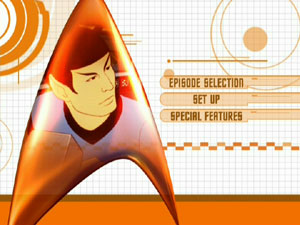
On Disc 2, The Infinite Vulcan has a selection of Storyboards available. Incidentally, the was Walter Koenig’s episode; writing this one helped to make up for being left out of the cast for the animated series. Another great Text Commentary appears on Disc 3’s The Eye Of The Beholder.
My only beef with the bonus material is that the commentaries do not appear on a menu screen for Special Features. They are only found on an individual episode’s menu. This is fine if you are going through the set one episode at a time, but if you are simply selecting “Play All”, you can miss out on some good stuff.
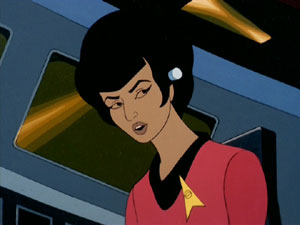
This means that the only disc to have a Special Features menu is Disc 4. To find Bem’s Audio Commentary By David Gerrold, you have to go to the Bem menu. (With this commentary, Gerrold goes deeper into his love for Nichelle Nichols, discusses the evolution of this episode, and where the name “Bem” came from.) Likewise, go to the episode menus to find the Audio Commentary By David Wise on How Sharper Than A Serpent’s Tooth, and the Text Commentary for The Counter-Clock Incident (where we learn more about author Fred Bronson, and numerous allusions to classic Trek episodes that Bronson included).
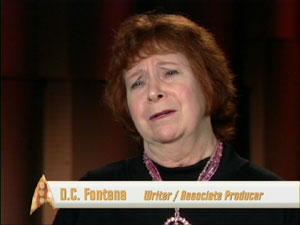
Under the Special Features menu, though, you will find a great selection. Drawn To The Final Frontier: The Making Of Star Trek The Animated Series (24:21) discusses making the animated show, which Dorothy Fontana points out was never referred to as a “cartoon.” Other interviewees include Gerrold, director Hal Sutherland, producer Lou Scheimer, and more. Some discuss the advantages of using animation to tell stories (while skimming past the issue of how limited it was), and the topic of whether or not the series is “canon” is brought up again. We even see footage of Lou accepting his Daytime Emmy for the show, and it is pointed out that Star Trek never received an Emmy in its 1966-69 run. The featurette is very nicely produced, and reminded me greatly of the fine featurettes found on BCI’s animation sets; and sure enough, BCI and BCI special content producer Andy Mangels do get “special thanks.”
What’s The Star Trek Connection? (5:44) traces aspects of the Trek mythos through all the series, on eleven topics. It becomes clear here just how much the animated show is integrated into Trek history. Lastly, Show History provides some useless text that simply rehashes what has already been covered elsewhere. Ignoring this final entry, Paramount has put together a better package than fans could have hoped for. All that is missing is participation from the actors.
Case Study:
Fans of custom packaging should enjoy this one. Patterned somewhat after the Star Trek: The Original Series DVD sets, this one comes in a sturdy plastic case shaped like… um, is it a communicator? There is a shaded window through which more packaging is revealed inside, featuring headshots of the characters. The four discs are in a plastic “flip book”, kept inside a paper sleeve, along with a booklet that provides an episode guide and some brief discussion on the show. So long as you don’t mind taking it all apart and putting it back together, it’s a smart-looking package.
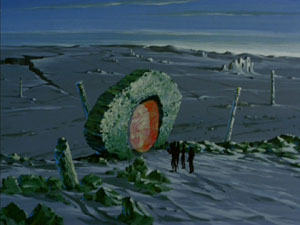
Ink And Paint:
The series appears to have been remastered, as it looks sharper than ever. Colors are bright, and print defects are few. Even considering the time period and budget, this show looks pretty good. There are naturally the usual smudges and dust to be seen, but the prints are otherwise in good shape. I saw very occasional combing artefacts, which will annoy some, but generally this is a very satisfying image that is above average for being from 1973.
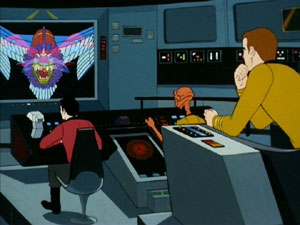
Scratch Tracks:
I cannot say that the new 5.1 track is tremendously impressive, but it does offer up a nicely nuanced sound design that was not ever available when watching this show previously. There are a few scattered surround effects, but overall the improvements over the also-included mono track are subtle. A Spanish is track is also available; and English, Spanish, and Portuguese subtitles are included.
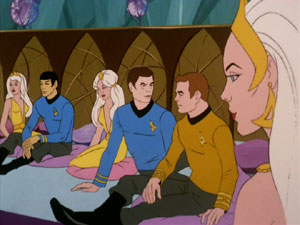
The theme for the animated series is original, though reminiscent of Alexander Courage’s original series theme. The music used in the episodes is nice enough; it’s just too bad that it’s recycled so much in each story. After watching a few episodes, you may wish that they did without any music at all. When discussing the voice work, it is mandatory to mention that all the original series’ principle players provided voices for their characters— except for poor Walter Koenig. His Chekov character was bumped in favor of keeping Nurse Chapel! Some fans might think this an odd choice but I don’t suppose that had anything to do with Chapel being voiced by Roddenberry’s wife (Majel Barret)? Well, it did allow for another female on the show besides Uhura, and kept Nichelle Nichols from having to voice every female that appeared on the show. James Doohan (Scotty) did a number of additional voices on the show (over 50!), covering many one-shot characters with various accents. When needed, the show did allow for the return of special guest stars, such as Mark Lenard’s performance as Sarek in Yesteryear, Stanley Adams as Cyrano Jones in More Tribbles, More Troubles, and Roger Carmel as Harry Mudd in Mudd’s Passion.
Final Cut:
I know that some will balk at this simply because it is animated, or because the animation is standard, 1973-level television limited animation. But if you give the show a chance, you will find that the scripts are on par with the original series (the good and the bad, but mainly the good), and the characters are still the same old Enterprise crewmates. I had a blast revisiting the show, and recommend that other Trekkers give it a try. At the very least, the show represents an intriguing period for the Star Trek franchise, when the syndicated reruns were bringing in impressive numbers, but before a movie series had been hatched. The generous extras bring it all into perspective, and after watching the whole set I think you will agree that the animated series stands as a proud part of the Star Trek family of television shows.
 | ||
 |







